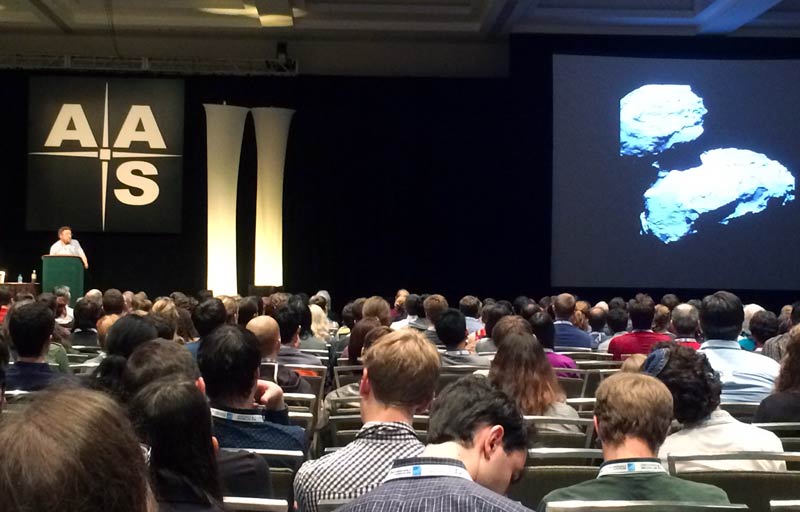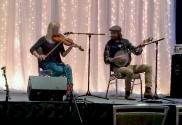223rd American Astronomical Society Meeting
American Astronomical Society Meeting
January 5, 2014 to January 9, 2014
Washington D.C.
Meeting host: By:Sara Frederick
SPS Chapter:

The theme of the 2014 American Astronomical Society (AAS) Winter meeting could well have been . Through various outreach and astronomical education events and talks, the message was loud and clear: Share your knowledge and data effectively. As an undergraduate often surrounded by snowy-white heads nodding vigorously at statements I struggled to understand, I appreciated the effort.
The theme of the 2014 American Astronomical Society (AAS) Winter meeting could well have been connecting with the public. Through various outreach and astronomical education events and talks, the message was loud and clear: Share your knowledge and data effectively. As an undergraduate often surrounded by snowy-white heads nodding vigorously at statements I struggled to understand, I appreciated the effort.
I am a junior physics and astronomy major from the University of Rochester and I attended the meeting to present a research poster from a summer research experience at Hope College in Holland, MI. My project involved updating a population synthesis of radio and gamma-ray millisecond pulsars with new statistical methods and new data from Fermi Gamma-ray Space Telescope.
Getting to the meeting from my hometown in rural Nebraska during January’s “polar vortex” was no small feat, but the experience was well worth it. The University of Rochester SPS chapter had one other student in attendance, Alexandra Kuznetsova (’14), and we look forward to passing on the outreach information and knowledge we gained by attending this meeting. Our chapter engages in activities such as an annual soccer match against the Optics department, as well as free tutoring on campus in our physics library. I am also part of the chapter’s outreach program, which puts on events and demos for young students and science clubs in the city of Rochester.
Alyssa Goodman elicited awe the first night with her talk “Linking Visualization and Understanding in Astronomy,” during which she showcased cutting-edge multidimensional imaging techniques which would allow the public to interact with data more than ever. Neil deGrasse Tyson rounded out the evening, encouraging scientists to take advantage of the public’s interest in astronomy (evidenced by images of space tattoos, scientific memes, and his ever-expanding Twitter fandom) by sharing knowledge through “tasty” soundbites. He received hearty applause following the trailer for “Cosmos: A Spacetime Odyssey”, which premiered on Fox early this March. Another great talk which spoke to the importance of mediating with the non-scientific community was given by Nicholas Suntzeff of Texas A&M University. A recipient of the Jefferson Science Fellowship, he discussed his sometimes shocking experiences of how science is perceived in government, and his work to improve scientific literacy in public policy.
While all these great speakers and more were laying out the call for astronomers to improve their interaction with the public, some in attendance were already answering this call. My favorite session of the entire meeting was on astronomy and education research; I wager I was not alone, as the tiny room it took place in was packed wall-to-wall. I especially liked Katherin Follette’s talk “Science Literacy’s Neglected Twin: Numeracy,” which encouraged educators not to forgo difficult topics in astronomy just because the math may be hard for some undergraduates to handle. Overall, the session focused on improving attitudes toward science and better approaches for informing the next generation, and the ideas were met with overwhelmingly positive reactions from the audience of educators.
The Society of Physics Students national organization made many appearances at the AAS meeting, most noticeably at the Evening of Undergraduate Science. There, students showcased their posters in a more informal setting and heard from astrophysicist Kathryn Flanagan, deputy director of the Space Telescope Science Institute. In addition, the Society of Physics Students welcomed students with a booth at the AAS Undergraduate Orientation. Many SPS members were also in attendance for the AAS’s first ever Open-Mic Talent Night, where feats of musical, theatrical, and yo-yo prowess were enjoyed by all. In addition to the scheduled events, members from all across the states joined together for meals and card games at the end of each long day.
Some of the most sensational findings unveiled at the meeting include the discovery of a stellar triple system, a supernova seen creating fresh dust, the latest prediction of the gas cloud G2 on a path to interact with the galactic black hole in March, a measurement of the scale of the universe within 1% accuracy, and the discovery by Kepler of the first earth-mass planet transiting its host star.
The AAS Winter meeting was my first scientific conference of this magnitude, and I was incredibly impressed by the generous sharing of information across scientists of all ages. I was also greatly touched by how much each senior scientist encouraged the undergraduates in attendance. During my poster session, big names in pulsar research and gamma-ray surveys approached me, asking more about my population study. Although their knowledge of the subject far outweighed mine, no one was disrespectful – on the contrary, I was provided with helpful suggestions about how to improve the code, along with encouragement to continue in the field. Presenting at a meeting of over 3,000 astronomers can be a daunting task, and each and every onlooker was incredibly supportive. I cannot wait to attend the next AAS meeting and, in the meantime, pass on my incredible experiences from the largest gathering of undergraduate astronomers on Earth.
Areas of Alignment: Career Resources: Scientific Categories:

